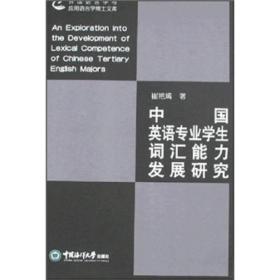
中国英语专业学生词汇能力发展研究
¥ 25 九五品
库存2件
浙江杭州
认证卖家担保交易快速发货售后保障
作者崔艳嫣 著
出版社中国海洋大学出版社
出版时间2008-03
装帧平装
货号750
上书时间2023-08-05
- 在售商品 暂无
- 平均发货时间 15小时
- 好评率 暂无
- 最新上架
商品详情
- 品相描述:九五品
图书标准信息
- 作者 崔艳嫣 著
- 出版社 中国海洋大学出版社
- 出版时间 2008-03
- ISBN 9787811251333
- 定价 25.00元
- 装帧 平装
- 开本 其他
- 纸张 其他
- 页数 174页
- 丛书 外国语言学与应用语言学博士文库
- 【内容简介】
- 《中国英语专业学生词汇能力发展研究》首先构建了第二语言词汇能力的多维模型,该模型包含四个可测维度:词汇量、词汇深度知识、词汇组织模式与词汇语义自主。然后采用了多种信度、效度较高的测试手段,从多个角度对词汇能力的各个维度的发展进行了深入细致的考察。研究发现,英语专业学生词汇能力各个维度的发展具有各自独特的规律,而且在发展过程中具有相关性。这一结论对二语词汇习得的理论建构与实证研究具有启示意义。
- 【目录】
-
Acknowledgements
Abstract
前言
ListofFigures
ListofTables
ListofAbbreviations
TableofContents
Chapter1Introduction
1.1Researchorientation
1.2Rationale
1.3Outlineofthedissertation
Chapter2LiteratureReview
2.1Introduction
2.2AhistoricalretrospectofL2vocabularyteachingandresearch
2.3Conceptualizationoflexicalcompetence
2.3.1Word-centereddefinitionsoflexicalcompetence
2.3.1.1Narrowdefinitionsoflexicalcompetence
2.3.1.2Dimensionaldefinitionsoflexicalcompetence
2.3.1.3Continuum-baseddefinitionsoflexicalcompetence
2.3.1.4Representation-orienteddefinitionsoflexicalcompetence
2.3.2Lexicon-centereddefinitionsoflexiealcompetence
2.3.2.1Meara'sframework
2.3.2.2Chapelle'sframework
2.3.2.3Henriksen'sframework
2.3.2.4Qian'sframework
2.3.2.5ZhangandWu'sframework
2.3.2.6Jiang'sframework
2.3.3Summary
2.4Theoreticalandempiricalexplorationsintolexicaldevelopment
2.4.1Developmentofvocabularysize
2.4.1.1Terminologicalissuesrelatedtovocabularysize
2.4.1.2Measurementofreceptiveandproductivevocabulary
2.4.1.3EmpiricalstudiesonL1andL2vocabularysize
2.4.1.4Summaryandunsolvedproblems
2.4.2Developmentofdepthofvocabularyknowledge
2.4.2.1Measurementofdepthofvocabularyknowledge
2.4.2.2Empiricalstudiesofdepthofvocabularyknowledge
2.4.2.3Summaryandunsolvedproblems
2.4.3Developmentoflexiealorganization
2.4.3.1Organizationofmentallexicon
2.4.3.2Wordassociationstudies
2.4.3.3Summaryandunsolvedproblems
2.4.4Developmentoflexicalsemanticautonomy
2.4.4.1Theform-meaningmappinginL2vocabularyacquisition
2.4.4.2Measurementoflexicalsemanticautonomy
2.5Conclusion
Chapter3ConceptualFrameworkandResearchDesign
3.1Introduction
3.2Atentativefr.ameworkofL2lexicalcompetence
3.3Workingdefinitionsandmeasuresforvariables
3.4Natureoftheresearchdesign
3.5Conclusion
Chapter4DevelopmentsofVocabularySizeandDepthofVocabularyKnowledge
4.1Introduction
4.2Researchquestions
4.3Researchmethod
4.3.1Subjects
4.3.2Instruments
4.3.2.1Questionnaire
4.3.2.2Testofreceptivevocabularysize
4.3.2.3Writingtaskelicitingproductivevocabulary
4.3.2.4Testofdepthofvocabularyknowledge
4.3.3Datacollectionprocedures
4.3.3.1Pilotstudy
4.3.3.2Twophasesofdatacollection
4.3.4DataPreparation
4.3.4.1Selectingsubjects
4.3.4.2MarkingtheVLT
4.3.4.3MarkingtheDVKT
4.3.4.4Preparingindicatorsofproductivevocabularysize
4.3.5Dataanalysis
4.4Results
4.4.1Developmentofreceptivevocabularysize
4.4.2Developmentofproductivevocabularysize
4.4.2.1Lexicalfrequencyprofile
4.4.2.2Lexicaldiversity
4.4.3Developmentofdepthofvocabularyknowledge
4.4.4RelationshipsamongRVS,PVSandDVK
4.5Discussion
4.5.1Receptivevocabularysize
4.5.2Productivevocabularysize
4.5.3Depthofvocabularyknowledge
4.5.4RelationshipsamongRVS,PVSandDVK
4.6Conclusion
Chapter5DevelopmentofLexicalOrganization
5.1Introduction
5.2Researchhypothesesandresearchquestions
5.3Researchmethod
5.3.1Subjects
5.3.2Elicitationinstrument
5.3.3Datacollectionprocedures
5.3.4Dataclassification
5.3.4.1Existingclassificationsystems
5.3.4.2Classificationmodelinthisstudy
5.3.4.3Scoringprocedures
5.3.5Dataanalysis
5.4Results
5.4.1Overalldevelopmentoflexicalorganization
5.4.2Developmentsinthefivecategoriesofassociations
5.4.2.1No-responsecases
5.4.2.2Clang-otherassociations
5.4.2.3Paradigmaticassociations
5.4.2.4Syntagmaticassociations
5.4.2.5Encyclopedicassociations
5.4.3Effectofwordfrequencyonresponsetypes
5.4.4Coincidentresponsesbetweenthesubjectsandthenativespeakers
5.4.5RelationshipsamongRVS,PVS,DVK,andLO
5.5Discussion
5.5.1Overalldevelopmentoflexiconorganization
5.5.2Developmentalfeaturesofthefivecategoriesofresponses
5.5.3Wordfrequencyandresponsetypes
5.5.4CoincidentresponsesbetweenL2learnersandnativespeakers
5.5.5RelationshipsamongRVS,PVS,DVKandLO
5.6Conclusion
Chapter6DevelopmentofLexicalSemanticAutonomy
6.1Introduction
6.2Researchquestion
6.3Researchmethod
6.3.1Subjects
6.3.2Semantic-relatednesstest
6.3.3Datacollectionprocedure
6.4Results
6.5Discussion
6.5.1L1mediationinL2wordprocessing
6.5.2DifferencesbetweenL1andL2vocabularyacquisition
6.5.3Instructionaltechniquestoovercomesemanticfossilization
6.6Conclusion
Chapter7Findings,ImplicationsandRecommendations
7.1Introduction
7.2Majorfindings
7.3Implications
7.3.1Theoreticalimplications
7.3.2Methodologicalimplications
7.3.3Pedagogicalimplications
7.3.3.1Raisingconsciousnessoflexicalcompetence
7.3.3.2Accommodatinglearners'needswithabalancedlexicalcourse
7.3.3.3Buildingupaweb-likenetworkofL2mentallexicon
7.3.3.4OvercomingsemanticfossilizationinL2vocabularyacquisition
7.4Limitationsofthepresentresearch
7.4.1Limitationbfconceptualizationoflexicalcompetence
7.4.2Limitationofpopulationgeneralizability
7.4.3Limitationofmethodology
7.5Directionsforfutureresearch
7.5.1Macrolevelstudies
7.5.2Microlevelstudies
7.5.3Suggestionsforresearchmethodologies
7.6Conclusion
References
Appendices
点击展开
点击收起
— 没有更多了 —






![非洲 (中国国家地理.美丽的地球系列),[意]乔凡尼·朱塞佩·贝拉尼 著,中国大百科全书出版社](https://www0.kfzimg.com/sw/kfz-cos/kfzimg/bcfedada/f8bc9866cb74cab5_s.jpg)

![365天世界顶级高尔夫球场之旅(中英文双语典藏版),[美]西多尔斯基、崔志强 著,陕西师范大学出版社](https://www0.kfzimg.com/sw/kfz-cos/kfzimg/faeffbfd/2efdd3689876a11d_s.jpg)



以下为对购买帮助不大的评价